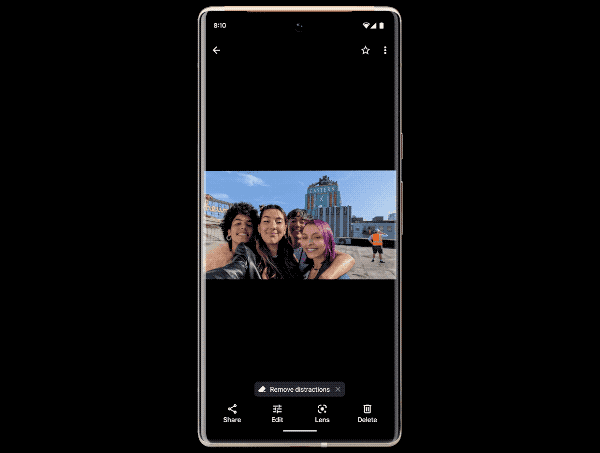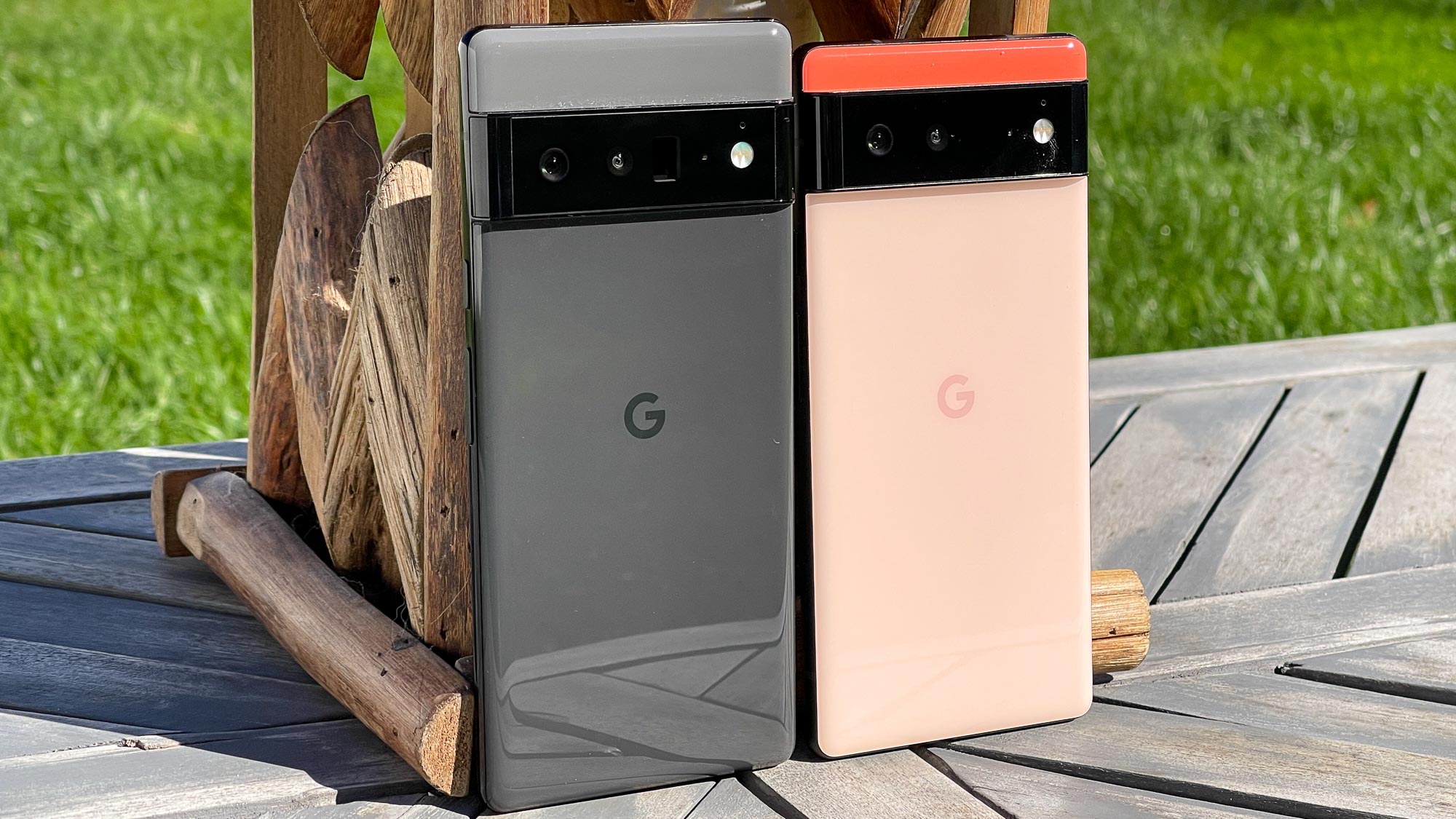Google Pixel 6 vs Pixel 6 Pro: These are the biggest differences

Editor's note: If you’re undecided as to which generation of Pixel you want, you'll want to read our Google Pixel 7 vs Google Pixel 6 breakdown. Otherwise, read on.
This Google Pixel 6 vs Google Pixel 6 Pro comparison is exactly what you need if you’re struggling to choose between last year’s flagship Google phones. These two phones have now been succeeded as flagships by the Google Pixel 7 and its bigger sibling the Google Pixel 7 Pro, which we think is one of the best phones around. But that doesn’t mean the older versions aren’t great devices, especially when you consider that they're now dropping in price. In fact, while the Pixel 6 and 7 both start at the same $599 starting point, we've seen the Pixel 6 deals as low as $199 in the past, which represents incredible value for money. But first, you'll need to decide which Pixel 6 to choose.
We were impressed by both devices in our Google Pixel 6 review and Google Pixel 6 Pro review. In general, the Pixel 6 is a massive step up from its predecessors, featuring the Tensor chipset as well as a sleek new design, powerful cameras and some hardware and software tweaks to tie everything together. Obviously, as you’d expect from its “Pro” moniker, the Pixel 6 Pro contains a heftier battery, a bigger display and a telephoto camera.
There are lots of other differences between the two, though, so we’ve laid out the features, prices and tech specs below to help you decide between the two.
Google Pixel 6 vs Pixel 6 Pro: Specs
| Header Cell - Column 0 | Google Pixel 6 | Google Pixel 6 Pro |
|---|---|---|
| Price: | $599 | $899 |
| Colors: | Stormy Black, Kinda Coral, Sorta Seafoam | Stormy Black, Cloudy White, Sorta Sunny |
| Display: size (resolution): | 6.4-inch (1080x2400 pixels, 411ppi) | 6.7-inch (1440 x 3120, 512ppi) |
| Refresh rate: | Up to 90Hz | Up to 120Hz |
| Processor: | Google Tensor with Titan M2 | Google Tensor with Titan M2 |
| RAM: | 8GB | 12GB |
| Storage: | 128GB | 256GB | 128GB | 256GB | 512GB |
| Rear cameras: | 50MP wide-angle (ƒ/1.85), 12MP ultrawide (ƒ/2.2) | 50MP wide-angle (ƒ/1.85), 12MP ultrawide (ƒ/2.2), 48MP telephoto (ƒ/3.5) |
| Zoom: | 7x Super Res digital | 4x optical and 20x Super Res digital |
| Front camera: | 8MP (ƒ/2.0), 84-degree field of view | 11.1MP (ƒ/2.2), 94-degree field of view |
| Video: | Rear: 4K and 1080p (both up to 60fps), Front: 1080p at 30fps | Rear: 4K and 1080p (both up to 60fps), Front: 4K at 30fps, 1080p at up to 60fps |
| Authentication: | Fingerprint Unlock with under-display fingerprint sensor | Fingerprint Unlock with under-display fingerprint sensor |
| Battery: | 4614 mAh | 5003 mAh |
| Battery life: | 8:13 | 7:53 |
| Dimensions: | 6.2 x 2.9 x 0.4 inches | 6.5 x 3 x 0.4 inches |
| Weight: | 7.3 ounces | 7.4 ounces |
Google Pixel 6 vs Pixel 6 Pro: Price and release date
The Pixel 6 and Pixel 6 Pro are arguably a bargain compared to their contemporaries like the iPhone 13 or the Samsung Galaxy S21, but there's still a $300 price gap between the two Pixel phones.
The base 128GB Google Pixel 6 starts at $599, with the option to pay more for 256GB of storage. The Pixel 6 Pro costs $899, with the option to pay for extra storage; only the Pixel 6 Pro goes up to 512GB.
Pre-orders for the Pixel 6 are now live if you've already made up your mind about the phone. The release date was 28 October 2021. See our Pixel 6 deals page for the biggest savings.
Get instant access to breaking news, the hottest reviews, great deals and helpful tips.
Google Pixel 6 vs Pixel 6 Pro: Design and display

The two Pixel 6 models look fairly similar with Gorilla Glass Victus on the front and back and a prominent camera bar on the back that separates two color blocks.
You have different color options for the two phones. The Pixel 6 comes in Stormy Black, Sorta Seafoam and Kinda Coral, while the Pro model has Stormy Black, Cloudy White and Sorta Sunny.
The two models diverge in a couple of areas. The most obvious would be size, with the Pixel 6 sporting a 6.4-inch OLED display and the Pixel 6 Pro offering a 6.7-inch panel. The other big difference is the camera total — the Pixel 6 has two cameras on the back, while the Pixel 6 Pro gets three.
Aside from the sizes, the displays on both phones also differ. The Pixel 6 sports a 90Hz refresh rate, while the Pixel 6 Pro goes to 120Hz. You get an FHD+ resolution panel on the base Pixel 6, whereas you get a shaper QHD screen on the Pixel 6 Pro.
In our lab tests, the Pixel 6 turned in an average brightness reading of 497 nits with adaptive brightness turned off and 843 nits with the setting turned on. The Pixel 6 Pro turned in a similar 495.3 nits and 842 nits, respectively.
The Pixel 6 panel registered 100.9% and 70.1% of the sRGB and DCI-P3 color spaces, while the Pixel 6 Pro hit 104.2% and 73.8% on the same tests. And the two phones were equally matched in terms of color accuracy with scored of 0.28 and 0.3 on the Delta-E test (where 0 is perfect).
Google Pixel 6 vs Pixel 6 Pro: Cameras

The basic Pixel 6 features two cameras on its back: a 50MP main camera and a 12MP ultrawide camera. The Pixel 6 Pro adds a third camera to this: a 48MP telephoto with 4x optical zoom and 20x digital zoom. The standard Pixel 6 has up 7x digital zoom.
Both phones use single 12MP cameras on the front, but with different fields-of-view. The Pixel 6's camera has an 84-degree FOV, while the Pixel 6 Pro gets a 94-degree FOV to fit more in frame.

There are new software abilities for these new cameras, too. Google has introduced a new Magic Eraser to help eliminate unwanted parts of photos, a Motion mode for long exposures and action shots, and Face Unblur to help bring definition to people's faces that the camera didn't quite capture.
There's lots to dig into with the Pixel 6 range's cameras, so check out our in-depth guide to all of the Google Pixel 6 camera upgrades. And be sure to check out our Pixel 6 review and Pixel 6 Pro review for photo comparisons with the iPhone 13.
Google Pixel 6 vs Pixel 6 Pro: Performance
Google has equipped the Pixel 6 with a new chip called Tensor, a reference to the company's machine learning hardware in its data centers. At the heart of Tensor is the Tensor Processor Unit (TPU), which will handle any and all AI tasks that the Pixel 6 and Pixel 6 Pro perform. That means that other resources could be freed for other tasks, potentially leading to better performance and battery life.
The two Pixel models are differentiated in terms of their memory capacities. The Pixel 6 has 8GB RAM and 128GB or 256GB of storage. The Pixel 6 Pro instead uses 12GB RAM, and either 128GB, 256GB or 512GB storage.
Google launches its phones with the latest version of Android each year. Therefore we see the Pixel 6 series come with Android 12 out of the box. Both will benefit from Google Assistant's latest tricks too, such as Live Translation for messages, media and voice, Quick Phrases for easier voice controls, and enhanced calling assistance.
The Pixel 6 and Pixel 6 Pro both fared well in benchmark testing, even if they're a step behind the iPhone 13 and Galaxy S21 series on some tests. On Geekbench 5, the Pixel 6 scored 1,029 and 2,696 on the single-core and multi-core tests; the Pixel 6 Pro reached a comparable 1,027 and 2,720.
On 3DMark Wild Life, which measures graphics performance, the Pixel 6 netted an average of 34 frames per second, and the Pixel 6 Pro got a higher 40 fps. The two handsets finished our video editing test in Adobe Premiere Rush in about the same amount of time: 48 seconds. That's good but not as fast as the iPhone 13's 26 seconds but it beats every other Android phone.
Google Pixel 6 vs Pixel 6 Pro: Battery and charging
The Google Pixel 6 packs a 4,614 mAh battery, and the Pixel 6 Pro has a larger 5,003 mAh battery. Google rates both phones for "beyond 24-hour battery life" and up to 4 8 hours with Extreme Battery Saver mode turned on.
On the Tom's Guide battery test, the Pixel 6 turned in a disappointing time of 8 hours and 13 minutes and the Pixel 6 Pro's best time was 7:53. The phones our best phone battery life list last 11 hours, and we consider 10 hours or above good. However, this is just one battery test and you can get more endurance in everyday use with Google's Tensor chip optimizing things for you, such as prioritizing apps over others.
Neither the Pixel 6 nor Pixel 6 Pro come with a charger, but both phones support faster charging for 50% capacity in 30 minutes when you use a 30W USB-C charger. Both phones also support fast wireless charging, with the Pixel 6 rated for 21W and Pixel 6 Pro 23W with Google's optional Pixel Stand (2nd gen).
Google Pixel 6 vs Pixel 6 Pro: Bottom line

The $899 Pixel 6 Pro earns its name compared to the basic Pixel 6. With an extra rear camera, a larger and faster 120Hz display, and more memory, it's got plenty of hardware that will allow it to go toe-to-toe with Samsung's and Apple's latest phones.
However, the regular Pixel 6 is the phone to get if you want the best value. For $599, you get a 6.4-inch 90Hz display and great cameras. Plus, you'll enjoy the same powerful Tensor processor, helpful software and photo features like Magic Erase.
It basically comes down to how much you're willing to pay for a larger screen and telephoto zoom.
After you've made your purchase, be sure to check out the best Google Pixel 6 cases and the best Google Pixel 6 Pro cases to protect your investment.

Richard is based in London, covering news, reviews and how-tos for phones, tablets, gaming, and whatever else people need advice on. Following on from his MA in Magazine Journalism at the University of Sheffield, he's also written for WIRED U.K., The Register and Creative Bloq. When not at work, he's likely thinking about how to brew the perfect cup of specialty coffee.
- Peter WolinskiSenior Editor, Reviews & Cameras
